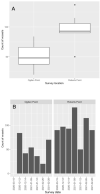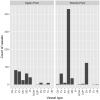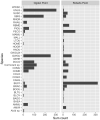Visual surveys provide baseline data on small vessel traffic and waterbirds in a coastal protected area
- PMID: 37053152
- PMCID: PMC10101382
- DOI: 10.1371/journal.pone.0283791
Visual surveys provide baseline data on small vessel traffic and waterbirds in a coastal protected area
Abstract
The coastal waters of southern British Columbia, Canada, encompass habitat of international conservation significance to coastal and marine birds, including sizeable areas designated in the early 1900s as Migratory Bird Sanctuaries (MBS) to protect overwintering waterfowl from hunting near urban centres. Two of these, Shoal Harbour (SHMBS) and Victoria Harbour (VHMBS), have seen significant marine infrastructure development in recent decades and experience considerable vessel traffic. Vessel-related stressors are known to affect waterbirds, but traffic characteristics in coastal urban areas are poorly understood for the smaller vessels not tracked by Automatic Identification Systems (AIS). We conducted a pilot study using shore-based observers to develop small-vessel baselines for the winter months, when regional waterbird numbers are highest. During our surveys we recorded considerable inter-site variability in vessel traffic characteristics, with one site (SHMBS) a source of nearly twice as many vessel transits as the other (VHMBS). Most recorded vessels were small watercraft (mean length 26 ± 17', mode 18'), and vessels at the high-traffic site were both shorter and faster on average. One in six vessels were classified as 'noisy', of interest given that noise is an important component of vessel disturbance of waterbirds and other marine animals. Few vessels (7% of all recorded) were of the type required to carry AIS transponders, which highlights the monitoring gap created by using AIS-based approaches alone in nearshore waters, and allows for correction of AIS-derived vessel counts. Waterbird community composition also varied by locality, with one site dominated by gulls (Laridae), cormorants (Phalacrocoracidae), and seaducks (Tribe Mergini), and the other by gulls, cormorants, and alcids (Alcidae). Our results demonstrate that fine-scale local variability must be taken into account when managing for vessel traffic disturbance of waterbirds, particularly at sites of high human population density and increasing coastal development.
Copyright: © 2023 Blight et al. This is an open access article distributed under the terms of the Creative Commons Attribution License, which permits unrestricted use, distribution, and reproduction in any medium, provided the original author and source are credited.
Conflict of interest statement
The authors have declared that no competing interests exist.
Figures






References
-
- Burger AE, Fry DM. 1993. Effects of oil pollution on seabirds in the northeast Pacific. In Vermeer K, Briggs KT, Morgan KH, Siegel-Causey D, editors. The status, ecology, and conservation of marine birds of the North Pacific. Ottawa: Canadian Wildlife Service Special Publication; 1993. pp. 254–263.
-
- Hentze N. The effects of marine vessel traffic on marine birds in British Columbia: A literature review. Technical Report Series No. 2020. Delta (BC): Canadian Wildlife Service, Pacific and Yukon Region; 2020. ix + 90 pp.
-
- Carreño A, Lloret J. Environmental impacts of increasing leisure boating activity in Mediterranean coastal waters. Ocean Coast Manag. 2021;209:105693.
-
- Carney KM, Sydeman WJ. A review of human disturbance effects on nesting colonial waterbirds. Waterbirds. 1999;22:68–79.
Publication types
MeSH terms
Associated data
LinkOut - more resources
Full Text Sources
Miscellaneous

